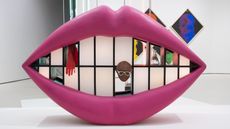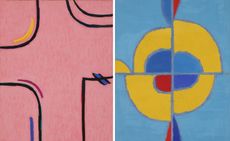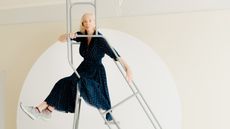Art and Seoul: global galleries are flocking to Korea’s capital
In recent years, Seoul has become a creative magnet for global galleries and art fairs, but why? SuhYoung Yun speaks to those at the heart of the art boom in South Korea’s capital

Foundry Seoul, a gallery owned by a Korean pipe manufacturing company, opened in June 2021 beneath the new Gucci flagship store in the affluent neighbourhood of Hannam-dong. Designed by Seoul-based architecture and interior design studio Intg, it’s just another addition to the district’s already thriving local art scene, which has more than a dozen galleries within a 5km radius, making it a key part of the wider Korean art boom.
Next to the Han River, Hannam-dong is increasingly popular among international galleries opening their first Seoul outposts, or expanding their existing footprints in the city.
Pace Gallery recently relocated to a space four times bigger than its previous Seoul location – next to the Leeum Museum owned by Samsung – and Thaddaeus Ropac will be opening its first Asian outpost in Hannam-dong in October 2021, which will feature interiors designed by Seoul-based designer Teo Yang. Yang was also responsible for Kukje Gallery’s K1 multi-use arts complex, which won Best Cultural Draw in the Wallpaper* Design Awards 2021.

Exterior view of Thaddaeus Ropac in Hannam-dong, Seoul, which will open in October 2021, marking the gallery’s first Asian outpost
Local galleries such as BHAK, Gallery Joeun and Gallery Baton have all settled in Hannam-dong, and Gana Art Center has two exhibition spaces there.
The rise of Hannam-dong as a sweet spot for galleries catering to wealthy local collectors coincides with Seoul’s ascent as an art and culture hub in Asia. Berlin-based gallery König relocated its Asian outpost from Tokyo to Seoul in April 2021, settling in the MCM building in the upscale fashion district of Cheongdam-dong. Frieze art fair will be holding its first Asia fair in the capital in September 2022.
Why has Seoul become a magnet for international galleries and art fairs?

Exterior view of König gallery, Seoul. Courtesy of the artist and KÖNIG GALERIE, Berlin, London, Seoul.
‘It’s a creative, cool, interesting [city],’ says Victoria Siddall, board director of Frieze. ‘Korea has incredible music, food and architecture and just a lot of reasons for people to want to visit.’ What Frieze is looking for is a city ‘that has a great foundational art community, but also goes beyond the arts’, she says.
‘London, New York and Los Angeles are all cultural centres that have amazing communities of artists, galleries, museums, great art schools and sophisticated collecting scenes,’ she continues. ‘That's been the approach we've taken to fairs, and Seoul was the perfect addition.’

Frieze will launch its first Asia fair in Seoul in September 2022
Seoul’s burgeoning local art scene
‘It feels like Seoul and Korea have rapidly risen to be a major city and country in the global art world,’ says Kyu Jin Hwang, Asia director at Thaddaeus Ropac.
The Korean art scene has grown rapidly in the past five or six years, beginning with the Dansaekhwa boom, she says, which brought international attention to Korean art. ‘Big names such as Lee Ufan, Park Seo-Bo, Yun Hyong-keun, Chung Sang-hwa and Ha Chong-hyun were steadily promoted by local galleries such as Kukje and Hyundai, and as these artists started to garner global attention, naturally the market grew,’ says Hwang.


Top: Chung Chang-Sup, Kukje Gallery K1 Chung Chang-Sup solo exhibition installation view. Above: Park Seo-Bo. Kukje Gallery K2 The Art of Dansaekhwa installation view. Images provided by Kukje Gallery
RELATED STORY

‘I’ve lived in Europe for 15 years. Ten years ago, when we said Asia, people thought of China, Hong Kong or Japan. Now the contemporary Korean art market has established a strong foothold and I’m proud to be spending my career in the art industry as a Korean.’
‘All the right ingredients’
Despite the pandemic, the art world in Seoul hasn’t struggled. In fact, it’s actually faring better because of it, gallerists say. ‘Because people stayed at home, they spent what they would spend on travel on interior decoration and buying art. Online fairs have also become an effective way for people to consume art,’ says Hwang.
Soo Choi, managing director at König Seoul, also says the pandemic has helped bring art closer to people. ‘Since there are social limitations to what people can culturally enjoy, I think they have newly discovered how much they can experience in galleries. They’ve also started collecting art within their budget,’ says Choi.

Courtesy of the artist and KÖNIG GALERIE, Berlin, London, Seoul.
The lower barrier to entry has allowed galleries to be visited by a younger audience – another contributing factor to the burgeoning art scene. ‘I’ve been a gallerist for 15 years and I definitely notice that the audience is younger these days. Galleries weren’t easy places to visit but now the perception has changed, it’s somewhere they can visit freely,’ Choi continues. ‘People’s tastes have elevated as well.’
The influx of the younger audience cannot be explained without social media, which played a pivotal role in creating the art boom in Korea, says Youngjoo Lee, senior director at Pace gallery, which inagurated its new Seoul outpost with a solo show by American artist Sam Gilliam. ‘When it comes to contemporary art and understanding it, Koreans’ speed of communicating and sharing on social media is fastest, especially among young people,’ says Lee. ‘I think the biggest change in the market is that Korea is leading the trend in terms of introducing art [to the public].’
Wallpaper* Newsletter
Receive our daily digest of inspiration, escapism and design stories from around the world direct to your inbox.


Top: Exterior view of Pace Seoul. Above: Installation view of Sam Gilliam at Pace Seoul.
Could Seoul become Asia’s new art capital?
Socio-political factors are not to be dismissed in Seoul’s rise, however, as galleries are exiting Hong Kong to find a new Asian hub. Seoul is the most favourable option for many because it offers similar tax benefits to Hong Kong, as well as a growing cultural scene.
‘I don’t think we’ve fully taken advantage of Korea’s tax-free benefits until now. If Korea uses that to its advantage, not only will the Korean art market grow, Seoul can become a trading hub,’ says Choi of König.
‘Tax exemption for trading art has definitely played to our advantage,’ adds Lee of Pace. ‘The strong contemporary art scene, tax exemption, and popularity of Korean culture have made Seoul an attractive destination.’
As Siddall continues: ‘I think it [Seoul] has potential to be the art market capital in Asia just because it has all the right ingredients.’

The entrance of Foundry Seoul, a gallery which opened in June 2021, designed by architecture and interior design studio Intg.
-
 Three new coffee makers for a contemporary brew, from a casual cup to a full-on branded espresso
Three new coffee makers for a contemporary brew, from a casual cup to a full-on branded espressoThree new coffee makers, from AeroPress, Jura and Porsche x La Marzocco, range from the defiantly manual to the bells and whistles of a traditional countertop espresso machine
By Jonathan Bell Published
-
 Don't miss Luxembourg's retro-futuristic lab pavilion in Venice
Don't miss Luxembourg's retro-futuristic lab pavilion in VeniceAs the Venice Biennale enters its last few weeks, catch 'A Comparative Dialogue Act' at the Luxembourg Pavilion
By Amah-Rose Abrams Published
-
 A Berlin park atop an office building offers a new model of urban landscaping
A Berlin park atop an office building offers a new model of urban landscapingA Berlin park and office space by Grüntuch Ernst Architeken offer a symbiotic relationship between urban design and green living materials
By Michael Webb Published
-
 ‘Humanity is always the centre of my practice': Alex Prager's new work blurs the line between reality and fiction
‘Humanity is always the centre of my practice': Alex Prager's new work blurs the line between reality and fictionAlex Prager speaks to Wallpaper* about her new body of work, 'Western Mechanics', which opened at Lehmann Maupin in Seoul
By Gameli Hamelo Published
-
 An avant-garde Korean art movement resurfaces in LA
An avant-garde Korean art movement resurfaces in LALA's Hammer Museum gets its teeth into avant-garde Korean art with ‘Only the Young: Experimental Art in Korea, 1960s–1970s’
By Anne Soward Published
-
 Kim Whanki, ‘the father of abstraction in Korea’, is celebrated at Frieze Seoul
Kim Whanki, ‘the father of abstraction in Korea’, is celebrated at Frieze SeoulKim Whanki’s work has its moment at Frieze Seoul 2023, where it is reimagined for the digital age
By Ann Binlot Published
-
 Frieze Seoul 2023: everything you need to know
Frieze Seoul 2023: everything you need to knowFrieze Seoul 2023 focuses on Asian galleries as it opens its doors for the second time in COEX, Gangnam
By SuhYoung Yun Published
-
 14th Gwangju Biennale review: a stage for new voices and ancient ideas
14th Gwangju Biennale review: a stage for new voices and ancient ideasSouth Korea’s 14th Gwangju Biennale (until 9 July 2023) takes water as its central theme, in which climate, Daoism, historical trauma, local craft and voices of the marginalised float to the surface
By Will Jennings Published
-
 Cyprien Gaillard on chaos, reorder and excavating a Paris in flux
Cyprien Gaillard on chaos, reorder and excavating a Paris in fluxWe interviewed French artist Cyprien Gaillard ahead of his major two-part show, ‘Humpty \ Dumpty’ at Palais de Tokyo and Lafayette Anticipations (until 8 January 2023). Through abandoned clocks, love locks and asbestos, he dissects the human obsession with structural restoration
By Harriet Lloyd-Smith Published
-
 A’strict: the South Korean digital art collective bringing nature to urban life
A’strict: the South Korean digital art collective bringing nature to urban lifeAs part of our Generation Generative series, we spotlight a’strict, the artistic unit of South Korean digital media design company d’strict, whose immersive art aims to bring viewers closer to nature
By SuhYoung Yun Published
-
 Year in review: top 10 art interviews of 2022, chosen by Wallpaper* arts editor Harriet Lloyd-Smith
Year in review: top 10 art interviews of 2022, chosen by Wallpaper* arts editor Harriet Lloyd-SmithTop 10 art interviews of 2022, as selected by Wallpaper* arts editor Harriet Lloyd-Smith, summing up another dramatic year in the art world
By Harriet Lloyd-Smith Published